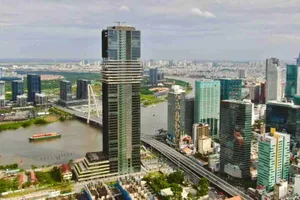
According to the State Bank of Vietnam (SBV), 2024 GDP growth reached 7.09 percent, with credit expanding by 15.08 percent, reaching a total value of VND15.6 quadrillion (US$611 billion). This implies that, on average, every 2-percent increase in credit contributes to a 1-percent rise in GDP.
While economic growth requires capital from diverse sources, the current weakness of medium- and long-term capital mobilization channels, such as the stock and bond markets, places a significant burden on the banking sector. Therefore, the SBV bears the responsibility of ensuring adequate credit supply to meet the 8-percent GDP growth target for 2025.
"To achieve the anticipated GDP growth this year, an estimated VND2.5 quadrillion ($97.9 billion) in credit will be injected into the economy (compared to VND2.1 quadrillion ($82.3 billion) last year). The paramount objective of monetary policy management is to support economic growth, while simultaneously controlling inflation and maintaining exchange rate stability," emphasized Permanent Deputy Governor Dao Minh Tu of the SBV.
Having received credit room allocations early, numerous commercial banks have formulated plans to deploy capital from the outset of the year, utilizing preferential loan packages, interest rate subsidies, streamlined procedures, and even developing programs tailored to individual businesses.
For instance, SeABank offers import-export firms preferential loans up to VND1 trillion ($39.2 million) and $100 million, with rates from 4 percent (USD) and 5.2 percent (VND). VPBank provides unsecured loans up to VND5 billion ($195,800) via simplified online applications at 5.5 percent. Agribank plans to inject an additional VND200 trillion ($7.8 billion) into the economy, leveraging its 13-percent credit room.
In HCMC, the SBV’s local branch reported that 18 commercial banks have registered credit packages totaling nearly VND200 trillion, with preferential interest rates, to participate in the 2025 Bank-Business Connection Program. Credit growth in January 2025 registered a 0.04-percent increase, contrasting with the negative growth typically observed in January in previous years.
To effectively stimulate credit growth, commercial banks are implementing various strategies, including prioritizing capital allocation to productive sectors.
General Director Pham Nhu Anh of MB stated that his bank will allocate at least 50 percent of its credit growth limit to the retail and SME segments, with the remainder focused on large enterprises. In addition to its primary focus on agriculture, rural areas, and farmers (who account for approximately 65 percent of total outstanding loans), Agribank will increase lending to key projects related to airports, seaports, roads, railways, and renewable energy.
Chairman Do Minh Phu of TPBank, revealed that his bank will participate in several expressway projects this year, including a recently signed VND2.4 trillion ($94 million) credit agreement for the Huu Nghi - Chi Lang Expressway BOT project, with disbursement to commence imminently.
According to Dr. Can Van Luc, Chief Economist at BIDV, based on the recovery momentum of 2024, traditional growth drivers such as exports, investment, and consumption are being revitalized, effectively combined with new drivers like science and technology, digital transformation, the green economy, energy transition, and the circular economy. Consequently, Vietnam’s economic growth in 2025 could well reach 8 percent.
Echoing this view, Assoc Prof Nguyen Huu Huan from HCMC University of Economics suggests that to disburse VND2.5 quadrillion ($97.9 billion) in 2025, further interest rate reductions are necessary. However, interest rates are likely to remain stable, given the sharp rise in domestic exchange rates, necessitating a cautious approach to monetary policy implementation.
Governor of the SBV Nguyen Thi Hong commented that in managing credit limits, the SBV targets 16-percent growth but may allow higher growth if inflation remains controlled, macroeconomic indicators stay within acceptable ranges, and growth targets are met. If commercial banks actively lend money to appropriate borrowers, and effectively utilize capital while maintaining safety and soundness, they will have greater flexibility.
The SBV will oversee and ensure overall credit growth for the economy, continuing to explore credit solutions, particularly those focused on production, business, and consumption to stimulate domestic demand. The SBV has also directed commercial banks to review and reduce costs to lower interest rates. The SBV will manage liquidity to ensure banks do not experience capital constraints.
Dr. Chau Dinh Linh from the University of Banking of Ho Chi Minh City voiced that if capital does not flow into production, it risks fueling asset bubbles. Credit growth and GDP are mutually reinforcing. However, rapid credit growth, with substantial funds being injected into the economy, can lead to inflation, asset bubbles, and rising non-performing loans if it does not flow into real production. This will have negative long-term consequences, ultimately slowing GDP growth.












)

)









